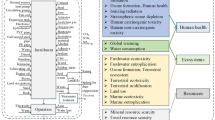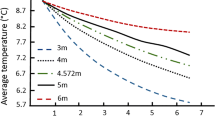Abstract
Ground-source heat pumps (GSHPs) have been widely applied in China in recent years. However, for heating-dominant buildings in cold regions, more heat from the ground is extracted than rejected, which leads to an annual decrease in heat source temperature and degradation of GSHP heating performance. In this study, a novel medium- to low-temperature enhanced geothermal combined with heat pump system (MLEGHP) is proposed for winter heating. Taking Shenyang city as an example, we technologically and economically investigate the applicability of this novel MLEGHP system in heating-dominated regions over a 30-year period. According to real geological data, hydraulic fracturing simulation, reservoir simulation, heating performance assessment, and economic analysis are conducted successively. Results indicate that the MLEGHP system can continuously work efficiently without performance deterioration and strengthen heating reliability during long-term operation in cold regions. Despite the high initial investment, the heat production and payback period of the system are considerable for large-scale projects. Thus, the MLEGHP system is a potential solution for the underground thermal imbalance of GSHP systems and for winter heating in cold regions.

















Similar content being viewed by others
Abbreviations
- C :
-
Leak-off coefficient
- D :
-
Darcy
- E :
-
Young’s modulus (MPa)
- g :
-
Gravitational acceleration (m/s2)
- H :
-
Height (m)
- I R :
-
Flow impedance (MPa/kg/s)
- K :
-
Permeability (D)
- K IC :
-
Fracture toughness (psi inch1/2)
- L :
-
Length (m)
- Q :
-
Thermal load (kW)
- P :
-
Pressure (MPa)
- q :
-
Flow rate (kg/s)
- T :
-
Temperature (°C)
- W :
-
Input power of pump (MW)
- z :
-
Depth (m)
- v :
-
Poisson’s ratio (–)
- σ H :
-
Maximum horizontal stress (MPa)
- σ h :
-
Minimum horizontal stress (MPa)
- σ V :
-
Vertical stress (MPa)
- η :
-
Energy efficiency
- ρ :
-
Density (kg/m3)
- μ :
-
Fluid viscosity (Pa s)
- COP:
-
Coefficient of performance
- EGS:
-
Enhanced geothermal system
- GCHP:
-
Ground-coupled heat pump
- GHE:
-
Ground heat exchanger
- GSHP:
-
Ground-source heat pump
- HDR:
-
Hot dry rock
- HP:
-
Heat pump
- MLEGHP:
-
Medium- to low-temperature enhanced geothermal combined with heat pump system
- TVDSS:
-
True vertical depth subsea
- f :
-
Fracture
- h :
-
Heat
- inj:
-
Injection
- max:
-
Maximum
- min:
-
Minimum
- p :
-
Pump
- pro:
-
Production
References
Abdeen MO (2008) Ground-source heat pumps systems and applications. Renew Sustain Energy Rev 12:344–371
Baria R, Baumgärtner J, Rummel F, Pine RJ, Sato Y (1999) HDR/HWR reservoir: concepts, understanding and creation. Geothermics 28:533–552
Brown DA (2000) Hot dry rock geothermal energy concept utilizing supercritical CO2 instead of water. In: Proceedings of the twenty-fifth workshop on geothermal reservoir engineering 2000. Stanford University, pp 233–238
Curtis R, Lund J, Sanner B, Rybach L, Hellström G (2005) Ground source heat pumps geothermal energy for anyone, anywhere: current worldwide activity. In: Proceedings World Geothermal Congress 2005, Antalya, Turkey
Davis AP, Michaelides EE (2009) Geothermal power production from abandoned oil wells. Energy 34(866e):72
Economides MJ, Nolte KG (2000) Reservoir stimulation, 3rd edn. Wiley, Hoboken, p 856
Final Report Summary (2015) Geothermal engineering integrating mitigation of induced seismicity in reservoirs, European Union
Geng Y, Sarkis J, Wang X et al (2013) Regional application of ground source heat pump in China: a case of Shenyang. Renew Sustain Energy Rev 18:95–102
Guo F (2011) Application of GSHP technology and analysis on its recharge and capability in Shenyang urban area. Agric Sci Technol Equip 200(2):97–99 (in Chinese)
Han ZW, Zheng MY, Kong FH, Wang F, Li ZJ, Bai T (2008) Numerical simulation of solar assisted ground-source heat pump heating system with latent heat energy storage in severely cold area. Appl Therm Eng 28(11–12):1427–1436
Haraden J (1992) The status of hot dry rock as an energy source. Energy 17(8):777–786
Hofmann H, Babadagli T, Zimmermann G (2014) Hot water generation for oil sands processing from enhanced geothermal systems: process simulation for different hydraulic fracturing scenarios. Appl Energy 113:524–547
Hua L, Fan R, Pan YQ, Huang ZH (2012) Review and development of integrated ground source heat pump systems. Refrig Air Cond 25(5):518–525 (in Chinese)
Julian JB, Stephen O, Jose MC et al (2006) Control of hazard due to seismicity induced by a hot fractured rock geothermal project. Eng Geol 83:287–306
Lund JW, Freeston DH, Boyd TL (2011) Direct utilization of geothermal energy 2010 worldwide review. Geothermics 40(3):159–180
McClure M, Horne R (2012) The effect of fault zone development on induced seismicity. In: Proceedings of the 37th workshop on geothermal reservoir engineering, 2012 January 30–February 8, Stanford University, Stanford, California
McClure M, Horne R (2012) Is pure shear stimulation always the mechanism of stimulation in EGS? In: Proceedings of the 38th workshop on geothermal reservoir engineering, 2012 February 11–13, Stanford University, Stanford, California
McDermott CI, Randriamanjatosoa ARL, Tenzer H, Kolditz O (2006) Simulation of heat extraction from crystalline rocks: the influence of coupled processes on differential reservoir cooling. Geothermics 35:321–344
Mortensen JJ (1978) Hot dry rock: a new geothermal energy source. Energy 3(5):639–644
Office of Energy Efficiency (2009) Heating and cooling with a heat pump groundsource heat pumps (earth-energy systems). Natural Resources Canada, Ottawa
Ozgener O, Hepbasli A (2005) Experimental performance analysis of a solar assisted ground-source heat pump greenhouse heating system. Energy Build 37(1):101–110
Pruess K (2006) Enhanced geothermal system (EGS) using CO2 as working fluid—a novel approach for generating renewable energy with simultaneous sequestration of carbon. Geothermics 35:351–367
Pruess K, Oldenburg C, Moridis G (1999) Lawrence Berkeley National Laboratory, TOUGH2 User’ s guide. Berkeley, CA, USA: Version 2.0
Schulte T, Zimmermann G, Vuataz F, Portier S, Tischner T, Junker R, Jatho R, Huenges E (2010) Enhancing geothermal reservoirs. In: Huenges E (ed) Geothermal energy systems—exploration, development and utilization. Wiley-VCH, Weinheim, pp 173–244
Self SJ, Reddy BV, Rosen MA (2013) Geothermal heat pump systems: status review and comparison with other heating options. Appl Energy 101:341–348
Tester JW, Livesay B, Anderson BJ, Moore MC, Bathchelor AS, Nichols K et al (2006) The future of geothermal energy: impact of enhanced geothermal systems (EGS) on the United States in the 21st century. An assessment by an MIT-led interdisciplinary panel
Trillat-Berdal V, Souyri B, Fraisse G (2006a) Experimental study of a ground-coupled heat pump combined with thermal solar collectors. Energy Build 38(12):1477–1484
Trillat-Berdal V, Souyri B, Fraisse G (2006b) Experimental study of aground-coupled heat pump combined with thermal solar collectors. Energy Build 38(12):1477–1484
Tsinghua University Building Energy Saving Research Center (2013) Annual report on china building energy efficiency. China Architecture and Building Press, Beijing (in Chinese)
von Cuba HL, Steimle F (1981) Heat pump technology. Butterworth Publishers, Dayton
Wan Z, Zhao Y, Kang J (2005) Forecast and evaluation of hot dry rock geothermal resource in China. Renewable Energy 30:1831–1846
Wang X, Zheng MY, Zhang WY, Zhang S, Yang T (2010) Experimental study of a solar-assisted ground-coupled heat pump system with solar seasonal thermal storage in severe cold areas. Energy Build 42(11):2104–2110
Watanabe K, Niibori Y, Hashida T (2000) Numerical study on heat extraction from supercritical geothermal reservoir. In: Proceedings World Geothermal Congress. Kyushu-Tohoku, Japan
Wei W, You T, Wang B, Shi W, Li X (2014) Evaluation of ground source absorption heat pumps combined with borehole free cooling. Energy Convers Manag 79:334–343
StimPlan™/InjecPlan™ version 6.00 [computer software]. Tulsa, Oklahoma: NSI Technologies
Yang W, Zhou J, Xu W, Zhang G (2010) Current status of ground source heat pumps in China. Energy Policy 38:323–332
You T, Wang B, Wei W, Shi W, Li X (2014) A new solution for underground thermal imbalance of ground -coupled heat pump systems in cold regions: heat compensation unit with thermosyphon. Appl Therm Eng 64:283–292
You T, Wang B, Wei W, Shi W, Li X (2015) Performance analysis of hybrid ground-coupled heat pump system with multi-functions. Energy Convers Manag 92:47–59
Yu X (2013) The research on volcanic sequence stratigraphy and its effect on reservoir eastern sag of Liaohe basin, NE China. PhD. 2013.6
Zeng YC, Su Z, Wu NY (2013) Numerical simulation of heat production potential from hot dry rock by water circulating through two horizontal wells at Desert Peak geothermal field. Energy 56:92–107
Zhang Y-J, Li Z-W, Guo L-L et al (2014) Electricity generation from enhanced geothermal systems by oilfield produced water circulating through reservoir stimulated by staged fracturing technology for horizontal wells: a case study in Xujiaweizi area in Daqing Oilfield, China. Energy 78:788–805
Zhou Q, Feng Z, Men G (2007) The relationships research between nowadays geothermal features and origin of natural gas in Xujiaweizi fault depression, north Songliao basin, vol 37. Science in China press, pp 177–188
Zoback MD (2007) Reservoir geomechanics, 1st edn. Cambridge University Press, Cambridge, p 464
Zongwei H, Maoyu Z, Fanhong K, Fang W, Zhongjian L, Tian B (2008) Numerical simulation of solar assisted ground-source heat pump heating system with latent heat energy storage in severely cold area. Appl Therm Eng 28:1427–1436
Zoveidavianpoor M, Samsuri A, Shadizadeh SR (2012) Development of a fuzzy system model for candidate-well selection for hydraulic fracturing in carbonate reservoirs. In: SPE oil and gas India conference and exhibition, Mumbai, India, 28–30 March, SPE 153200
Acknowledgments
This study was supported by the National High Technology Research and Development Program of China (863 Program) (No. 2012AA052801), the Natural Science Foundation of China (Grant No. 41372239), and the China Postdoctoral Science Foundation (No. 2014M551190).
Author information
Authors and Affiliations
Corresponding author
Rights and permissions
About this article
Cite this article
Yu, Z., Guo, L., Zhang, Y. et al. Feasibility analysis of a medium- to low-temperature enhanced geothermal combined with heat pump system (MLEGHP) for heating application in severely cold regions: a case study in Shenyang, Northeastern China. Environ Earth Sci 75, 920 (2016). https://doi.org/10.1007/s12665-016-5717-z
Received:
Accepted:
Published:
DOI: https://doi.org/10.1007/s12665-016-5717-z




